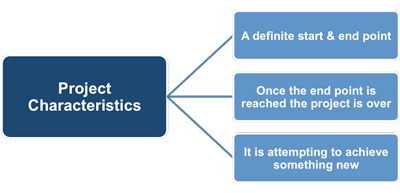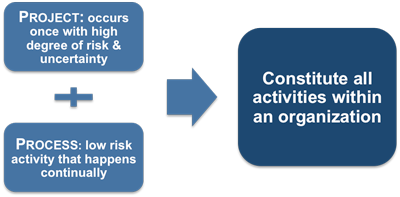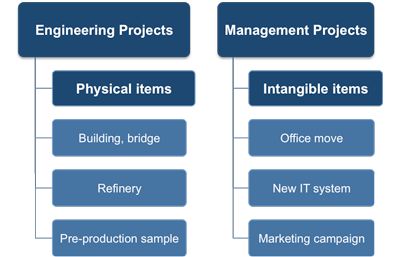Project Management Definition
Before concerning ourselves with the details of project management documents and processes, it is a good idea to take a step back and think about what makes something a project and why it needs to be managed differently from the day-to-day work of the organization. In other words,
'Why do we need project management?'
There are many different definitions of what constitutes a project:
Project Management Institute - 'A project is a temporary endeavor undertaken to create a unique product, service or result.'
PRINCE2 - 'A Project is a temporary organization that is created for the purpose of delivering one or more business products according to an agreed Business Case.'
Association for Project Management (APM) - 'An endeavor in which human material and financial resources are organized in a novel way to deliver a unique scope of work of given specification often within constraints of cost and time to achieve beneficial changes defined by quantitative and qualitative objectives.'
H. Kerzner - 'Project management is the planning, organizing, directing and controlling of company resources for a relatively short-term objective that has been established to complete specific goals and objectives. Furthermore, project management utilizes the systems approach to management by having functional personnel (the vertical hierarchy) assigned to a specific project (the horizontal hierarchy)' (2009).
Many organizations also have their own definition of what constitutes a project. Whichever definition you prefer does not really matter; the important thing is to be able to identify work that constitutes a project so that it can be properly managed.
 |
Projects have some or all of the following characteristics:
• They have a definite start and endpoint
• Once the endpoint is reached the project is over
• They are attempting to achieve something new
Projects can vary in size and small projects can be planned and managed by the same person whereas larger projects may employ thousands of people working on many sites and require a dedicated group in order to manage and coordinate the activities.
Everything that an organization does can be categorized either as a project or process. A process is something that happens continually and has a low risk associated with it, whereas a project happens once and has a relatively high level of risk.
To illustrate this, imagine an organization that has an annual staff appraisal process in which managers make a written assessment of their staff against criteria specified by the HR department. This is a process because even if the criteria change from year to year the procedure undertaken by everyone involved remains more or less the same.
 |
If the organization decided to introduce an IT system to facilitate this process then the selection, implementation, and testing of the new system would represent a project because it would be a one-off activity which carries the risk of exceeding the budget or timescale allocated to it.
It is perfectly logical for different organizations to see the same activity in a different way. For example, the supplier of the computer system may see this activity as a process because it is something that it does every time it sells a system. Each time it does so, it gains more experience, which allows it to plan and execute future installations based on what it has learned previously.
This distinction is important because project management is used where there is a high degree of uncertainty and risk because there is no experience of performing the activity.
So in this scenario,
The organization buying the system would treat it as a project.
The vendor would treat it as part of a process.
The vendor would see it as a process that could be refined with each iteration in order to reduce costs and increase the quality. The distinction between projects and processes depends on whether the organization repeats an activity often enough for it to become routine. Once an activity is repeated often enough within an organization to become routine it is no longer considered a project - it becomes one of their many management processes.
Projects can be broadly classified into engineering projects and management projects. Engineering projects encompass civil, electrical, and mechanical engineering and the final deliverables are physical objects, for example a building, reservoir, bridge, refinery, or pre-production sample. Specialist companies or consortia invariably undertake these types of project.
 |
Management projects include things like: restructuring the organization, preparing for an exhibition, developing an IT system, launching a new marketing campaign, moving offices, or indeed anything where the objective is to produce an end result that is not identifiable as a physical item. To gain a greater understanding of the different functions within these type of projects look at the range of free PDF Project Management eBooks on this website. .
A broad range of organizations do projects of this type, including: commercial companies, government departments, charities and NGOs (Non Governmental Organizations), and other not-for-profit organizations. The differences between these types of project are:
Use of Specialist Staff
Engineering projects almost always represent the day-to-day work of the organization. For example, a construction company will employ people who specialize in building office blocks, public buildings, houses, or roads.
Similarly, a manufacturing company will have design engineers to take a product from conception, through the design process and prototyping before the work is handed over to production engineers who will then be responsible for mass production.
This is quite different from a management project where people who don't usually run projects may find themselves doing much the work.
Environmental Issues
The challenges of engineering projects are often physical in nature. For example, a construction project may be held up by bad weather, the discovery of archeological remains, or other unforeseen environmental problems.
Management projects on the other hand usually take place on the organization's own premises and are not subject to these sorts of issues.
Specification of Final Deliverable
In the case of engineering projects the final deliverable is usually specified in detail at the beginning of the project because it will need to comply with existing standards or legislation. If the deliverable is a mechanical or electronic part then it will need to fit with the rest of the finished product.
This is not usually the case with management projects where the exact form of the final deliverable may not become clear until some of the work of the project has been done. It may also alter as the project develops, or in response to market research or other developments.
Generally speaking, engineering projects and management projects are quite different things and our project management eBooks are aimed at managers undertaking management projects rather than engineering projects.
You may also be interested in:
Project Management Principles | Project Management Definition | Project Management Perspectives | Project Organization and Structure | Projects in a Matrix-Management Environment | Project Stakeholders Definition | Project Sponsor Definition | Project Life Cycle Definition | Functional Areas of Project Management.
|
|


